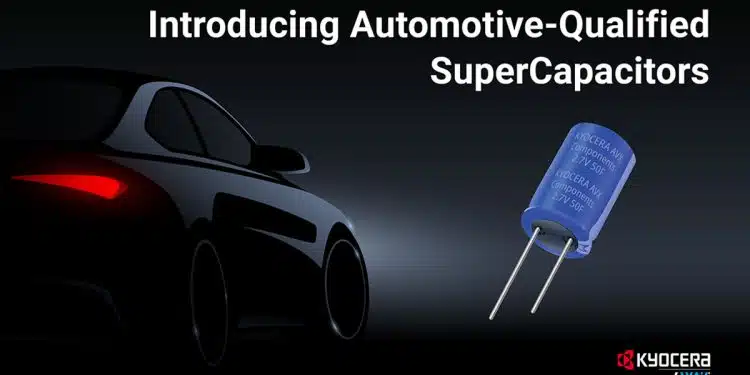KYOCERA AVX, a leading global manufacturer of advanced electronic components engineered to accelerate technological innovation and build a better future, is proud to announce its first automotive-qualified supercapacitors, which are also known as cylindrical, electrochemical, double-layer capacitors.
The five new automotive-qualified SCC Series supercapacitors are tested and qualified to the stringent AEC-Q200 standard, which proves their ability to reliably withstand test conditions designed to replicate challenging mechanical and electrical conditions common in automotive applications.
SCC Series supercapacitors have a ruggedly constructed form factor, deliver high-reliability performance, and exhibit very high capacitance, very low ESR, and excellent pulse power handling characteristics.
They can be used alone, or in conjunction with primary or secondary batteries, to extend backup times and battery life and leverage instantaneous pulse power. Ideal applications for the five new automotive-qualified supercapacitors include electronic mechanical latching, emergency calling, electronic recording, regenerative braking, power, and backup power systems.
The five new automotive-qualified SCC Series supercapacitors are rated for 25F and 2.7V, 100F and 2.7V, 10F and 3V, 35F and 3V, and 100F and 3V. They also comply with UL 810A, RoHS, and REACH requirements.
“We’re very proud to introduce our first automotive-qualified supercapacitors,” said Mamoon Abedraboh, Global Product Manager – Supercapacitor Products, KYOCERA AVX. “We introduced the first SCC Series supercapacitors in October 2016 and, in the years since, they have proven to deliver high-quality, high-reliability performance, optimal pulse power handling characteristics, and an impressive price-performance ratio in industrial and consumer applications all around the world. So, we’re very excited to offer solutions with those same outstanding characteristics to our automotive customers.”
Features
- Vdc 2.7V & 3.0V
- Cap values from 35F – 100F
- High pulse power capability
- Low ESR
- Low leakage current
Applications
- eLatch (Safety, Normal operation)
- eCall (Safety)
- Motor Stabilization
- eVideo
- Power backup
- Camera flash systems
- Energy harvesting
- GSM/GSR pulse applications
- UPS/Industrial
- Wireless alarms
- Remote metering
- Scanners
- Toys and games































